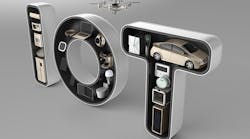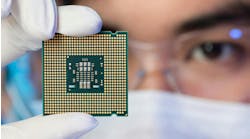Envisioning an advanced level of network connectivity where everyday objects like refrigerators, toasters, and wearable devices would send, receive, and share data among one another, inventors of the Internet of Things (IoT) are beginning to see their visions become reality. And while the notion of a toaster “talking” to a refrigerator may still be in development, IoT applications have already surfaced on both the industrial and consumer sides of the electronics market.
Research firm Gartner forecasts that 6.4 billion connected “things” will be in use worldwide this year, up 30% from 2015, and will reach 20.8 billion by 2020. In 2016, 5.5 million new things will get connected every day. Services are dominated by the professional category (in which businesses contract with external providers in order to design, install, and operate IoT systems), according to Gartner, but connectivity services (through communications service providers) and consumer services will grow at a faster pace.
On a Growth Path
Rob Lineback, senior market research analyst at IC Insights in Scottsdale, Ariz., paints a picture of an IoT market that could hit even bigger growth numbers than Gartner predicts over the next four years. He expects the IoT market to nearly double by 2019, with about 30 billion Internet connections expected to be in place worldwide in 2020.
According to Lineback, 85% of those attachments will be web-enabled “things,” meaning a wide range of commercial, industrial, and consumer systems, distributed sensors, vehicles, and other connected objects—and 15% will be electronics used by humans to communicate, download, and receive streams of data files, and search for online information. Wearable systems are projected to be the fastest-growing IoT application, says Lineback, with connected vehicles (passenger cars and light trucks) expected to be the second-fastest market category.
In assessing the various electronic components that go into IoT equipment and devices, Lineback says integrated circuits will be the primary components, with MCUs (microcontrollers) and SoC (system-on-chip) processors seeing the strongest growth. Microelectromechanical system (MEMS) sensors will also play an important role in the ongoing development of IoT, with those components being relied upon to measure changes in sound, motion, pressure, temperature, and light. In many cases, these sensors are paired with an application-specific integrated circuit (ASIC) or microprocessor (e.g., for programming capability).
The IoT Supply Chain
For buyers, Lineback says the IoT’s evolution presents some interesting challenges. When procuring electronic components, for example, he says buyers should have an understanding of whether the end product is heavily dependent on SoC design. If it is, he says issues like getting the components on time and within a reasonable price range could come into play.
“From a supply-chain point of view, there’s always going to be concern about availability,” says Lineback. “If you have a new IoT device that takes off like gangbusters, for example, you have to make sure you can get the parts in the door and your products shipped out on time.”
On the sensor side of the equation, Lineback says ongoing price erosion in the marketplace will probably keep costs down for the near future. “Price erosion for sensors is at a level we’ve never seen before,” he says. “That’s partly because everyone is racing to get the price of a [sensor] down to a dollar or less. As a result, it’s difficult for suppliers to attain an acceptable profit margin.”
Another Word for Embedded Systems?
Looking out to the rest of the year, Lineback sees the growth of IoT continuing to put pressure on sensor prices. But even with all of the hype around IoT right now—and the promises of a time when all devices and equipment talk to one another and share data—he says buyers should remember that the overall concept is really still in its infancy.
“We’re at a point where we’re trying to determine just how much of IoT is a ‘hot topic’ versus reality,” Lineback notes. “Right now, everyone is feeling the pressure to be in it, but at this juncture we see the IoT as an extension of the embedded systems world, which has been around for a long time. We’re basically just adding Internet connectivity and some other aspects of embedded design to the equation and calling it IoT.”








